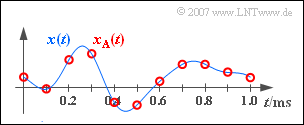Exercise 5.1: Sampling Theorem
From LNTwww
Given is an analog signal $x(t)$ according to the sketch:
- It is known that this signal does not contain any frequencies higher than $B_{\rm NF} = 4 \ \text{kHz}$.
- By sampling with the sampling rate $f_{\rm A}$ , the signal $x_{\rm A}(t)$ sketched in red in the diagram is obtained.
- For signal reconstruction a low-pass filter is used, for whose frequency response applies:
- $$H(f) = \left\{ \begin{array}{c} 1 \\ 0 \\ \end{array} \right.\quad \begin{array}{*{5}c} {\rm{{\rm{f\ddot{u}r}}}} \\ {\rm{{\rm{f\ddot{u}r}}}} \\ \end{array}\begin{array}{*{5}c} |f| < f_1 \hspace{0.05cm}, \\ |f| > f_2 \hspace{0.05cm} \\ \end{array}$$
The range between the frequencies $f_1$ and $f_2 > f_1$ is not relevant for the solution of this task.
The corner frequencies $f_1$ and $f_2$ are to be determined in such a way that the output signal $y(t)$ of the low-pass filter exactly matches the signal $x(t)$ .
Hints:
- This task belongs to the chapter Time-Discrete Signal Representation.
- There is an interactive applet for the topic dealt with here: Sampling of Analog Signals and Signal Reconstruction
Questions
Solution
(1) The distance between two adjacent samples is $T_{\rm A} = 0.1 \ \text{ms}$. Thus, for the sampling rate $f_{\rm A} = 1/ T_{\rm A} \;\underline {= 10 \ \text{kHz}}$is obtained.
(2) Proposed solutions 2 and 4 are correct:
- The spectrum $X_{\rm A}(f)$ of the sampled signal is obtained from $X(f)$ by periodic continuation at a distance of $f_{\rm A} = 10 \ \text{kHz}$.
- From the sketch you can see that $X_{\rm A}(f)$ can have signal parts at $f = 2.5 \ \text{kHz}$ and $f = 6.5 \ \text{kHz}$;.
- In contrast, there are no components at $f = 5.5 \ \text{kHz}$.
- Also at $f = 34.5 \ \text{kHz}$ will be valid $X_{\rm A}(f) = 0$.
(3) It must be ensured that all frequencies of the analog signal are weighted with $H(f) = 1$.
- From this follows according to the sketch:
- $$f_{1, \ \text{min}} = B_{\rm NF} \;\underline{= 4 \ \text{kHz}}.$$
(4) Likewise, it must be guaranteed that all spectral components of $X_{\rm A}(f)$, that are not contained in $X(f)$ are removed by the low-pass filter.
- According to the sketch, the following must apply:
- $$f_{2, \ \text{max}} = f_{\rm A} – B_{\rm NF} \;\underline{= 6 \ \text{kHz}}.$$

